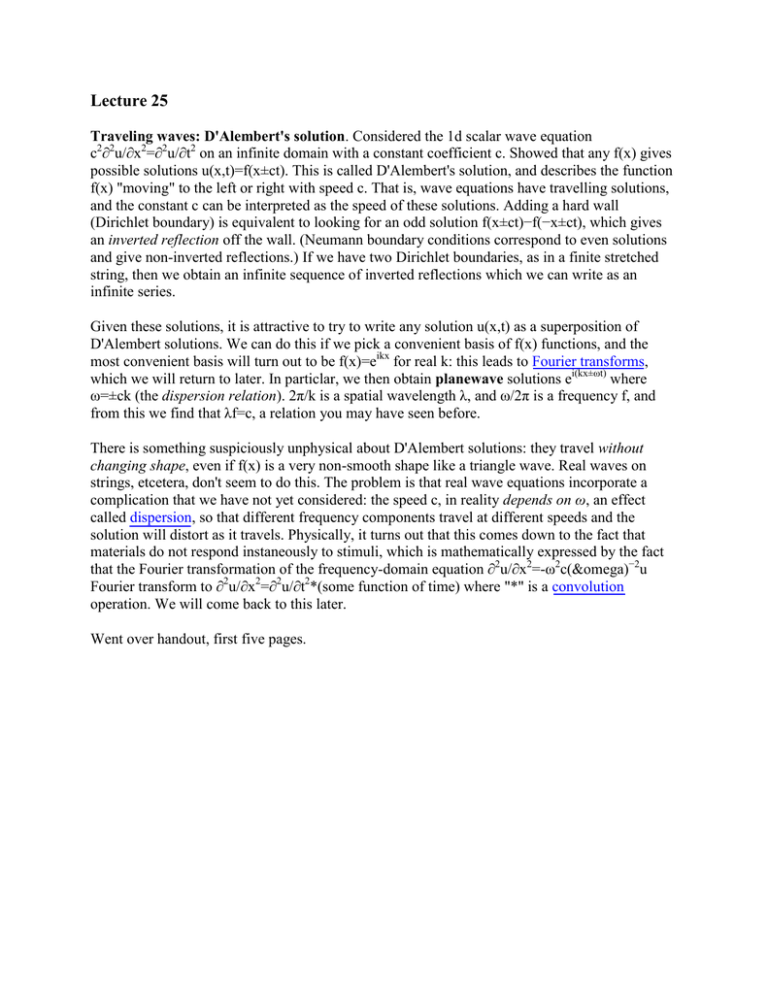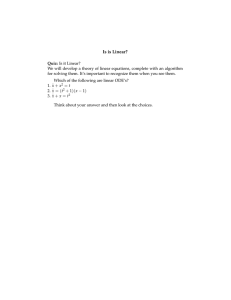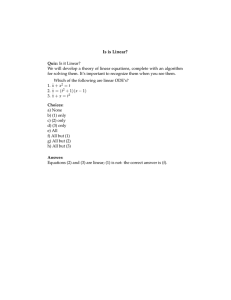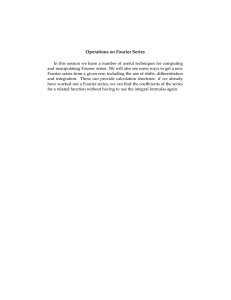Lecture 25
advertisement

Lecture 25 Traveling waves: D'Alembert's solution. Considered the 1d scalar wave equation c2∂2u/∂x2=∂2u/∂t2 on an infinite domain with a constant coefficient c. Showed that any f(x) gives possible solutions u(x,t)=f(x±ct). This is called D'Alembert's solution, and describes the function f(x) "moving" to the left or right with speed c. That is, wave equations have travelling solutions, and the constant c can be interpreted as the speed of these solutions. Adding a hard wall (Dirichlet boundary) is equivalent to looking for an odd solution f(x±ct)−f(−x±ct), which gives an inverted reflection off the wall. (Neumann boundary conditions correspond to even solutions and give non-inverted reflections.) If we have two Dirichlet boundaries, as in a finite stretched string, then we obtain an infinite sequence of inverted reflections which we can write as an infinite series. Given these solutions, it is attractive to try to write any solution u(x,t) as a superposition of D'Alembert solutions. We can do this if we pick a convenient basis of f(x) functions, and the most convenient basis will turn out to be f(x)=eikx for real k: this leads to Fourier transforms, which we will return to later. In particlar, we then obtain planewave solutions ei(kx±ωt) where ω=±ck (the dispersion relation). 2π/k is a spatial wavelength λ, and ω/2π is a frequency f, and from this we find that λf=c, a relation you may have seen before. There is something suspiciously unphysical about D'Alembert solutions: they travel without changing shape, even if f(x) is a very non-smooth shape like a triangle wave. Real waves on strings, etcetera, don't seem to do this. The problem is that real wave equations incorporate a complication that we have not yet considered: the speed c, in reality depends on ω, an effect called dispersion, so that different frequency components travel at different speeds and the solution will distort as it travels. Physically, it turns out that this comes down to the fact that materials do not respond instaneously to stimuli, which is mathematically expressed by the fact that the Fourier transformation of the frequency-domain equation ∂2u/∂x2=-ω2c(&omega)−2u Fourier transform to ∂2u/∂x2=∂2u/∂t2*(some function of time) where "*" is a convolution operation. We will come back to this later. Went over handout, first five pages. MIT OpenCourseWare http://ocw.mit.edu 18.303 Linear Partial Differential Equations: Analysis and Numerics Fall 2014 For information about citing these materials or our Terms of Use, visit: http://ocw.mit.edu/terms.


